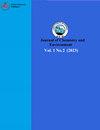香薷芽提取物活性成分的分离与表征
引用次数: 0
摘要
本研究主要对香合欢芽甲醇提取物的生物活性成分进行了分离鉴定。对各种溶剂组分进行生物测定和植物化学筛选,并对最有效的组分进行光谱分析,使用红外,质谱和核磁共振来确定存在的活性化合物的结构。方法采用甲醇提取香薷花蕾,用正己烷、乙酸乙酯和甲醇三种溶剂对植物提取物进行分馏,并用琼脂孔扩散法进行生物实验,确定三种溶剂组分的抑菌性能。分析结果显示,三种溶剂组分中的每一种都含有单宁、生物碱、类黄酮和还原糖;唯一含有皂苷的部分是乙酸乙酯部分,唯一含有糖苷的部分。研究结果进一步表明,乙酸乙酯部分对试验生物的抑菌活性最强,在浓度为200 mg/mL时,可抑制大肠杆菌、伤寒沙门氏菌、金黄色葡萄球菌、枯草芽孢杆菌、白色念珠菌等细菌的生长。通过红外、核磁共振和质谱等光谱分析方法对抗菌活性化合物进行了结构解析。该植物的抗菌活性突出了其提取物在传统药物制剂中的重要性,根据研究结果,这表明香合合花蕾的抗菌特性可能是由于所发现的植物成分的协同作用或单个作用。本文章由计算机程序翻译,如有差异,请以英文原文为准。
Fractionation and Characterization of the Bioactive Compounds of the Extracts of Buds of Syzygium aromaticum
This research focused on the separation and identification of bioactive components of the methanolic extracts of the buds of Syzygium aromaticum. A bioassay and phytochemical screening were performed on the various solvent fractions, and the most active fraction was subjected to spectroscopic analysis using infrared, mass spectroscopy, and nuclear magnetic resonance to determine the structure of the active compounds present. The methodology involved extracting the flower buds of Syzygium aromaticum using methanol, fractionating the plant extract using three solvents—n-hexane, ethylacetate, and methanol, and performing a bio Using the agar well diffusion method, the antibacterial properties of the three solvent fractions were ascertained. The analysis' findings revealed that each of the three solvent fractions had tannins, alkaloids, flavonoids, and reducing sugars; the only fraction to contain saponins was the ethylacetate fraction, and the only fraction to have glycosides. The results of the study further showed that the ethylacetate fraction had the strongest antimicrobial activity against the test organisms, inhibiting the growth of bacteria such as Escherichia coli, Salmonella typhi, Staphylococcus aureus, Bacillus subtilis, and Candida albicans at concentrations of 200 mg/mL. The structural elucidation of the active compounds responsible for the antimicrobial was done through spectroscopic analysis using infrared, nuclear magnetic resonance and mass spectroscopy. The antimicrobial activities of this plant highlighted the significance of the extracts in traditional drug preparations, according to the study's findings, which suggested that the antimicrobial properties of the flower buds of Syzygium aromaticum may be due to the synergetic or individual effects of the phytoconstituents found.
求助全文
通过发布文献求助,成功后即可免费获取论文全文。
去求助
来源期刊

Journal of Chemistry and Environment
Chemistry and Environmental Sciences-
自引率
0.00%
发文量
0
期刊介绍:
Journal of Chemistry and Environment (ISSN: 2959-0132) is a peer-reviewed, open-access international journal that publishes original research and reviews in the fields of chemistry and protecting our environment for the future in an ongoing way. Our central goal is to provide a hub for researchers working across all subjects to present their discoveries, and to be a forum for the discussion of the important issues in the field. All scales of studies and analysis, from impactful fundamental advances in chemistry to interdisciplinary research across physical chemistry, organic chemistry, inorganic chemistry, biochemistry, chemical engineering, and environmental chemistry disciplines are welcomed. All manuscripts must be prepared in English and are subject to a rigorous and fair peer-review process. Accepted papers will appear online within 3 weeks followed by printed hard copies.
Note: There are no Article Publication Charges. (100% waived). Welcome to submit your Mini reviews, full reviews, and research articles.
Journal of Chemistry and Environment aims to publish high-quality research in the following areas: (Topics include, but are not limited to, the following)
• Physical, organic, inorganic & analytical chemistry
• Biochemistry & medicinal chemistry
• Environmental chemistry & environmental impacts of energy technologies
• Chemical physics, material & computational chemistry
• Catalysis, electrocatalysis & photocatalysis
• Energy, fuel cells & batteries
Journal of Chemistry and Environment publishes:
• Full papers
• Reviews
• Minireviews
 求助内容:
求助内容: 应助结果提醒方式:
应助结果提醒方式:


